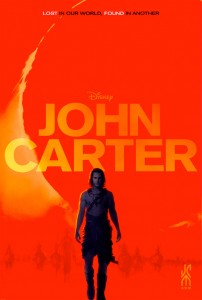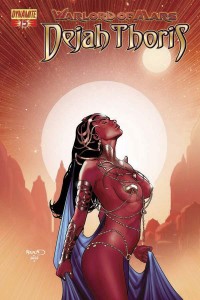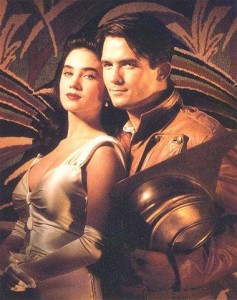 Disney announced it was writing down major losses on their extreme-budget franchise hopeful John Carter, all but conceding it is headed into history books as an unmitigated flop. Critics have been relatively kind to it, with the movie not receiving particularly abysmal oversight from them, and some were actually praising the attempt to bring Tarzan creator Edgar Rice Burroughs’ other epic to the screen. This movie has everything, apparently, except audiences. Why did it fail?
Disney announced it was writing down major losses on their extreme-budget franchise hopeful John Carter, all but conceding it is headed into history books as an unmitigated flop. Critics have been relatively kind to it, with the movie not receiving particularly abysmal oversight from them, and some were actually praising the attempt to bring Tarzan creator Edgar Rice Burroughs’ other epic to the screen. This movie has everything, apparently, except audiences. Why did it fail?
To answer that, we need to look clear-eyed at what the movie market is right now. There are movies for everyone now, but not a single movie that everyone agrees on. That fracturing has spilled across the landscape of the cineplex where, once, a family went to the movies together. Now they split off and go see the feature that was tailored for them. Of this splintering, the once consistent goal of studios is to have the franchise that appeals to the golden 14-21 year old market. This is the demographic that is gladly moving from Scholastic Book series such as Harry Potter (a coming of age series about a boy in strange, adult dangers and situations), Twilight (a soap opera), and The Hunger Games (youths thrown into the violence of war before they are equipped to comprehend it) right to box office bonanzas. Where the scope of these was once meant for a wider range of ages, now the films are firmly meant to connect with the pre-teen and teen demographic, possibly to the exclusion of people 25-and-up.
Into this comes John Carter, Burroughs’ story of a Civil War fighter magically transposed to Mars, or as the inhabitants know it, Barsoom. Under the hot desert sun of Barsoom is everything you would think a young teenage male could want: action, setpieces, spaceships, special effects, and scantily clad girls. What a teenage boy might not be so keen on being seen going to is a movie fronted by a scantily clad guy, but the character of John Carter has been seemingly pulled directly from a teenage girl’s fan magazine. One suspects that the people at Disney saw this as a way of getting both the boys and the girls to see it.
That’s not how it works. In the world of teenage politics, the guy wants a movie with other rough and tough guys shooting stuff, driving cool vehicles and wearing slick body armor and outfits. They want the girls to wear little to nothing. This is why Michael Bay keeps making lots and lots of money. The girl wants to be with the guy and so she acquiesces to going to this loud, shiny travesty with him.
Conversely, the girl wants to go see a movie she can relate to with mysterious boyfriends that pull the female protagonists out of their mundane existences. The guy doesn’t want to see that, but if he’s ever going to get to second base, he’ll suffer through the throngs of sparkly vampires, and that is also how you get both sexes to pay for the ticket. You do not try to appeal to them both at once.
 But that’s what Disney attempts here by mixing a sci-fi manchild actioner with a beefcake lead role. Worse, Taylor Kitsch who plays John Carter doesn’t look like a Civil War veteran. He looks like a mix between Conan the Barbarian and one of those creepy-loungey dudes on the Abercrombie & Fitch ads. The other thing that Disney did was to pull way back from Burroughs’ original conception of the inhabitants of Barsoom who are, uh, er, nekkid as jaybirds. Witness the many, many, many comic interpretations of the lead female character of Dejah Thoris (the “Princess of Mars” that this first book/movie focuses on). Even they have to pull back from Burroughs, but still languish in a middle-school mentality of titillation (yeah, I know what I wrote there). So the fact that the lead male character is running around in a loin-cloth essentially while the female is practically prudish by comparison makes little sense.
But that’s what Disney attempts here by mixing a sci-fi manchild actioner with a beefcake lead role. Worse, Taylor Kitsch who plays John Carter doesn’t look like a Civil War veteran. He looks like a mix between Conan the Barbarian and one of those creepy-loungey dudes on the Abercrombie & Fitch ads. The other thing that Disney did was to pull way back from Burroughs’ original conception of the inhabitants of Barsoom who are, uh, er, nekkid as jaybirds. Witness the many, many, many comic interpretations of the lead female character of Dejah Thoris (the “Princess of Mars” that this first book/movie focuses on). Even they have to pull back from Burroughs, but still languish in a middle-school mentality of titillation (yeah, I know what I wrote there). So the fact that the lead male character is running around in a loin-cloth essentially while the female is practically prudish by comparison makes little sense.
Disney’s done this before though, specifically with the adaptation of the comic series The Rocketeer wherein the lead character’s love interest is modeled after pin-up queen Bettie Page. In the film she is turned into a thoroughly chaste Jennie, as played by Jennifer Connelly. I think the movie still works as a bit of a throwback, fun adventure, but it bombed and is considered an afterthought in the Disney archive. Am I saying that Disney should have attempted an all-naked sci-fi film in John Carter, just for the sake of being true to the source material? No, of course not, but if they were going to pull back in one aspect, they should have pulled back in others to maintain an equilibrium. They could have both the male and female characters in outfits that said “space adventure” of some sort (but that would likely have shown how much of Flash Gordon had been cribbed from the John Carter novels). Instead, they wanted to have it both ways and got neither. With The Rocketeer, they had to pull back because the character upon which Jennie was based wasn’t going to make it in a Disney film without severe controversy. Then again, perhaps it should have been one of their subsidiaries at that time, Touchstone or Hollywood Pictures.
As I’ve mentioned on several occasions, opening weekend has become a place where it is about being seen. You go to show off. You put on your best sneakers, your skinniest jeans, your best shirt, maybe some gold if you’re feeling ostentatious. You’re not going to go to a movie that’s going to make you look bad. People are watching and, on Monday, people will talk. If you are or have ever been in high school, you’re already aware of this. Movies are an entertainment, yes; but they’re also a fashion statement. You listen to the hot hits on your iPod, you spray the latest cologne/perfume on and blend in, and you go to the movie that won’t make you look weak. It may not be the easiest thing to test-market for, this ephemeral definition of coolness, because it seems to be changing by the minute. However, if you insist on making movies so slavishly and narrowly engineered, you had better try.
 Here’s the thing though. Like The Rocketeer, John Carter is not awful. It’s not what I could call an epic for the ages, but if you dug the old Hercules TV series, you would enjoy this. It may find an audience on DVD, and I expect that in true Disney fashion it will quietly be dumped on the home video market in a month or two like so much trash in the river, in an unheralded single-disc, movie-only ceremonial washing of the hands. For all of Hollywood’s test marketing and previewing and reworking, Disney failed to understand the targets they were purportedly aiming for, and for that lack of critical thinking now have to figure out how to justify the loss of a couple hundred million dollars.
Here’s the thing though. Like The Rocketeer, John Carter is not awful. It’s not what I could call an epic for the ages, but if you dug the old Hercules TV series, you would enjoy this. It may find an audience on DVD, and I expect that in true Disney fashion it will quietly be dumped on the home video market in a month or two like so much trash in the river, in an unheralded single-disc, movie-only ceremonial washing of the hands. For all of Hollywood’s test marketing and previewing and reworking, Disney failed to understand the targets they were purportedly aiming for, and for that lack of critical thinking now have to figure out how to justify the loss of a couple hundred million dollars.
John Carter![]()
is available from Amazon.com.






Comments